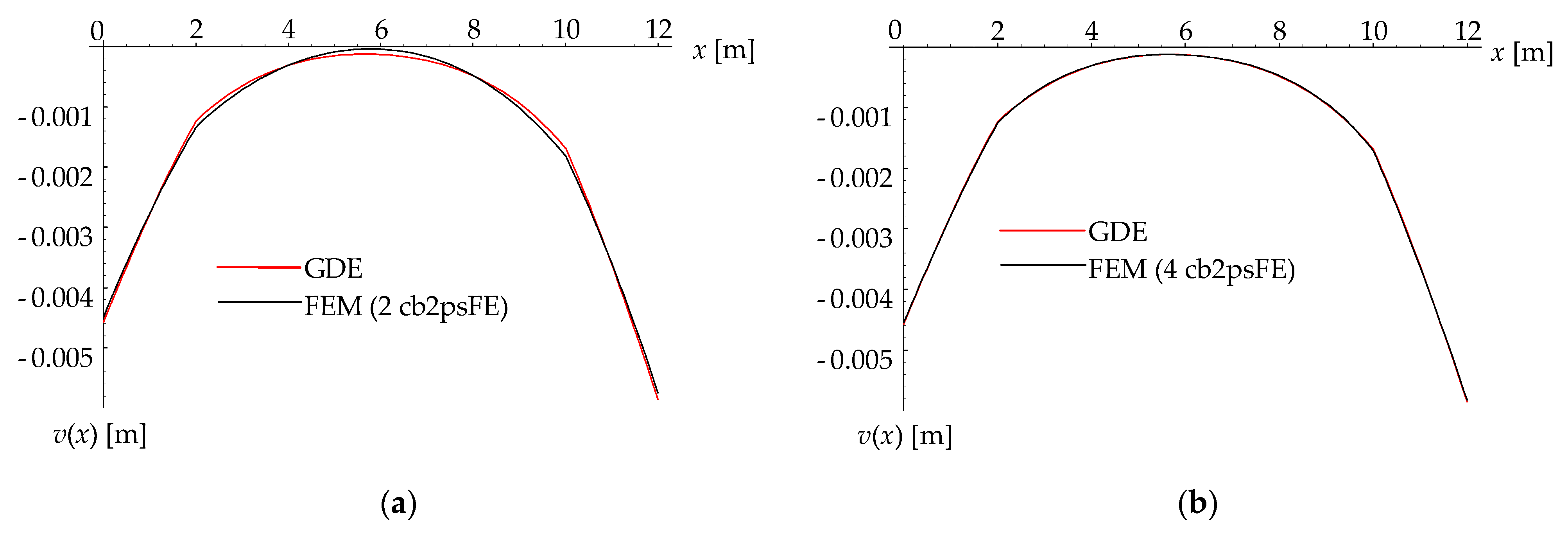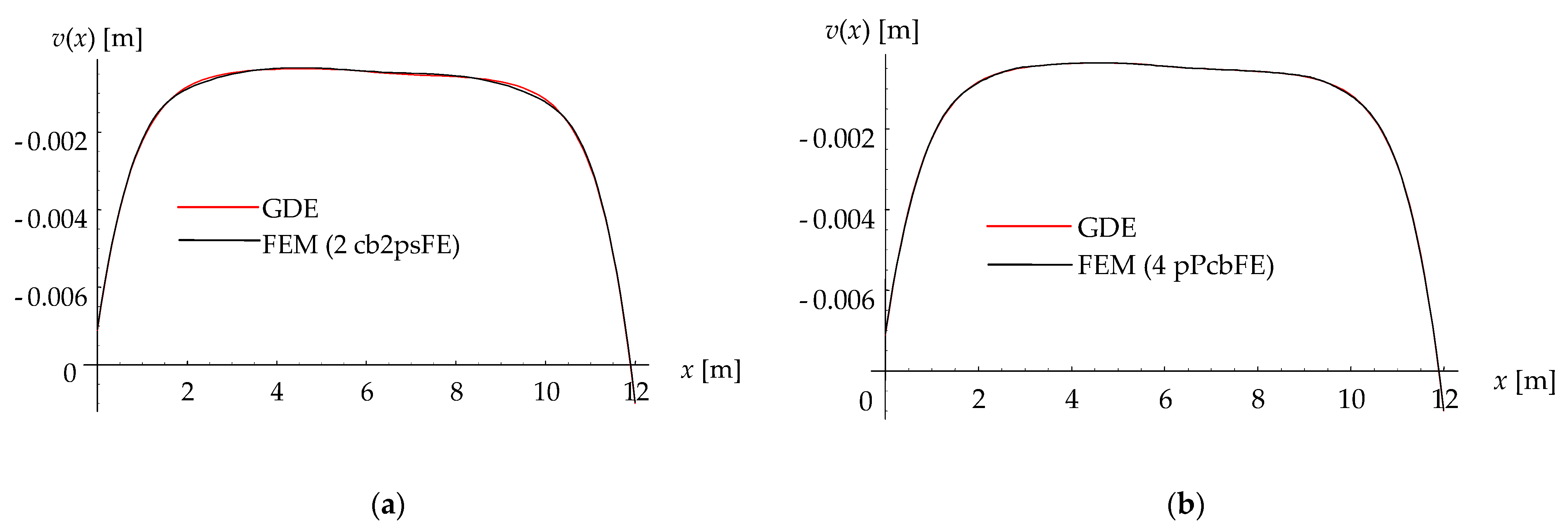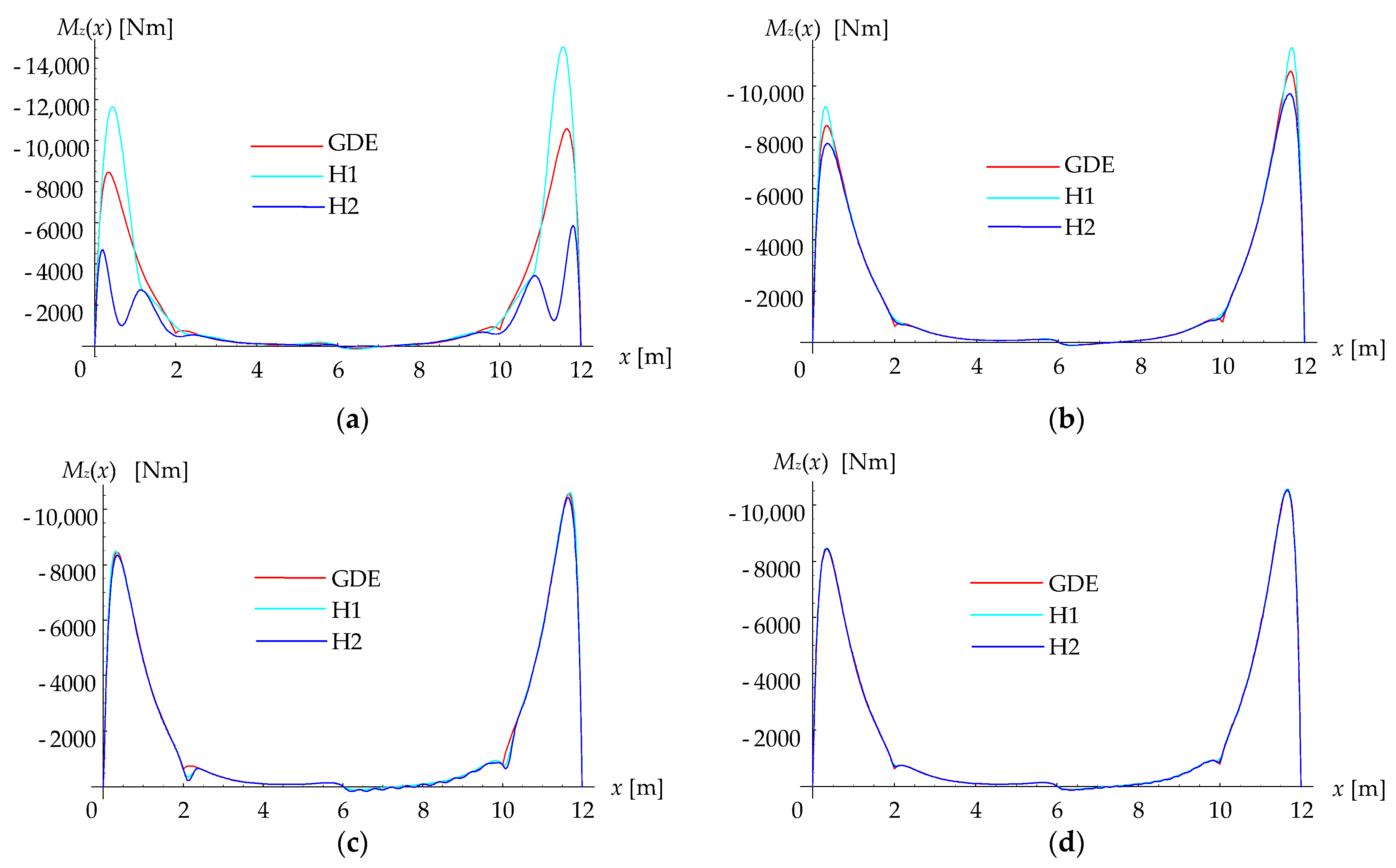A New Beam Finite Element for Static Bending Analysis of Slender Transversely Cracked Beams on Two-Parametric Soils
Abstract
:1. Introduction
2. Basic Assumptions and General Analytical Formulation
3. Derivation of a New Finite Element
3.1. Derivation of Interpolation Functions of the Cracked Beam on the Two-Parametric Medium
3.2. Derivation of Matrices of the Cracked Beam on the Two-Parametric Medium
3.3. Derivation of Load Vector Due to a Continuous Load q(x) over the Whole Element
3.4. Computation of Nodal Shear Forces and Bending Moments
3.5. Calculation of Bending Moment Functions
3.6. Calculation of Shear Force Functions
4. Verification Numerical Examples and Discussion
4.1. First Example
4.2. Second Example
5. Conclusions
- FEM bending analysis of slender cracked uniform beams resting on a two-parametric soil was considered.
- The second soil parameter was directly implemented in the new transverse displacement interpolation functions.
- The FE’s complete stiffness matrix consists of three separately derived matrices belonging to the beam and both soil contributions.
- The presented solutions converge to the exact differential equations solutions independently of the value of the coefficient λ2.
- Derived solutions in the closed symbolic form are applicable for all two-parametric soil models that have the same governing differential equation.
Author Contributions
Funding
Institutional Review Board Statement
Informed Consent Statement
Data Availability Statement
Acknowledgments
Conflicts of Interest
References
- Okamura, H.; Liu, H.-W.; Chu, C.-S.; Liebowitz, H. A Cracked Column under Compression. Eng. Fract. Mech. 1969, 1, 547–564. [Google Scholar] [CrossRef]
- Skrinar, M. A Finite Element of a Cracked Prismatic Beam on Elastic Foundation. Geotech. Eng. Transp. Syst. Environ. Prot. Proc. 1995, 2, 409–414. [Google Scholar]
- Skrinar, M.; Lutar, B. Analysis of Cracked Slender-Beams on Winkler’s Foundation, Using a Simplified Computational Model. Acta Geotech. Slov. 2011, 8, 5–17. [Google Scholar]
- Alijani, A.; Abadi, M.M.; Darvizeh, A.; Abadi, M.K. Theoretical Approaches for Bending Analysis of Founded Euler–Bernoulli Cracked Beams. Arch. Appl. Mech. 2018, 88, 875–895. [Google Scholar] [CrossRef]
- De Rosa, M.A.; Lippiello, M. Closed-Form Solutions for Vibrations Analysis of Cracked Timoshenko Beams on Elastic Medium: An Analytically Approach. Eng. Struct. 2021, 236, 111946. [Google Scholar] [CrossRef]
- Winkler, E. Die Lehre von Der Elasticitaet Und Festigkeit: Mit Besonderer Rücksicht Auf Ihre Anwendung in Der Technik, Für Polytechnische Schulen, Bauakademien, Ingenieure, Maschinenbauer, Architecten, Etc.; Verlag von H. Dominicus: Prague, Czech Republic, 1867. [Google Scholar]
- Skrinar, M.; Imamović, D. Exact Closed-form Finite Element Solution for the Bending Static Analysis of Transversely Cracked Slender Elastic Beams on Winkler Foundation. Int. J. Numer. Anal. Methods Geomech. 2018, 42, 1389–1404. [Google Scholar] [CrossRef]
- Selvadurai, A.P. Elastic Analysis of Soil-Foundation Interaction; Elsevier: Amsterdam, The Netherlands, 2013; ISBN 0-444-59628-3. [Google Scholar]
- Ostachowicz, W.M.; Krawczuk, M. Vibration Analysis of a Cracked Beam. Comput. Struct. 1990, 36, 245–250. [Google Scholar] [CrossRef]
- Liang, R.Y.; Hu, J.; Choy, F. Theoretical Study of Crack-Induced Eigenfrequency Changes on Beam Structures. J. Eng. Mech. 1992, 118, 384–396. [Google Scholar] [CrossRef]
- Hasan, W.M. Crack Detection from the Variation of the Eigenfrequencies of a Beam on Elastic Foundation. Eng. Fract. Mech. 1995, 52, 409–421. [Google Scholar] [CrossRef]
- Sundermeyer, J.N.; Weaver, R.L. On Crack Identification and Characterization in a Beam by Non-Linear Vibration Analysis. J. Sound Vib. 1995, 183, 857–871. [Google Scholar] [CrossRef]
- Ma, X.; Butterworth, J.W.; Clifton, G.C. Static Analysis of an Infinite Beam Resting on a Tensionless Pasternak Foundation. Eur. J. Mech. A/Solids 2009, 28, 697–703. [Google Scholar] [CrossRef]








| Solution | vA (mm) | vC1 (mm) | vB (mm) | vC2 (mm) | vC (mm) |
|---|---|---|---|---|---|
| GDEs | −4.57025 | −1.23163 | −0.12909 | −1.68105 | −5.85171 |
| 2 cb2psFE | −4.48993 | −1.33539 * | −0.04154 | −1.80843 * | −5.74653 |
| 4 cb2psFE | −4.55059 | −1.25081 * | −0.12998 | −1.70517 * | −5.82683 |
| 6 cb2psFE | −4.56149 | −1.22663 | −0.12945 | −1.67464 | −5.84065 |
| 8 cb2psFE | −4.56849 | −1.23202 * | −0.12925 | −1.68155 * | −5.84949 |
| 10 cb2psFE | −4.56950 | −1.23200 * | −0.12916 | −1.68152 * | −5.85077 |
| 12 cb2psFE | −4.56983 | −1.23141 | −0.12912 | −1.68077 | −5.85119 |
| Solution | vA (mm) | vC1 (mm) | vB (mm) | vC2 (mm) | vC (mm) |
|---|---|---|---|---|---|
| GDEs | −7.10145 | −0.82797 | −0.43899 | −1.15046 | −8.99332 |
| 2 cb2psFE | −7.08739 | −0.88593 * | −0.42891 | −1.22572 * | −8.97526 |
| 4 cb2psFE | −7.09083 | −0.84549 * | −0.44200 | −1.17304 * | −8.98006 |
| 6 cb2psFE | −7.09121 | −0.83208 | −0.44032 | −1.15551 | −8.98052 |
| 8 cb2psFE | −7.09091 | −0.84219 * | −0.43912 | −1.16822 * | −8.98014 |
| 10 cb2psFE | −7.09237 | −0.83551 * | −0.43905 | −1.15987 * | −8.98197 |
| 12 cb2psFE | −7.09418 | −0.82692 | −0.43902 | −1.14915 | −8.98423 |
Publisher’s Note: MDPI stays neutral with regard to jurisdictional claims in published maps and institutional affiliations. |
© 2021 by the authors. Licensee MDPI, Basel, Switzerland. This article is an open access article distributed under the terms and conditions of the Creative Commons Attribution (CC BY) license (https://creativecommons.org/licenses/by/4.0/).
Share and Cite
Skrinar, M.; Uranjek, M.; Peruš, I.; Imamović, D. A New Beam Finite Element for Static Bending Analysis of Slender Transversely Cracked Beams on Two-Parametric Soils. Appl. Sci. 2021, 11, 10939. https://doi.org/10.3390/app112210939
Skrinar M, Uranjek M, Peruš I, Imamović D. A New Beam Finite Element for Static Bending Analysis of Slender Transversely Cracked Beams on Two-Parametric Soils. Applied Sciences. 2021; 11(22):10939. https://doi.org/10.3390/app112210939
Chicago/Turabian StyleSkrinar, Matjaž, Mojmir Uranjek, Iztok Peruš, and Denis Imamović. 2021. "A New Beam Finite Element for Static Bending Analysis of Slender Transversely Cracked Beams on Two-Parametric Soils" Applied Sciences 11, no. 22: 10939. https://doi.org/10.3390/app112210939
APA StyleSkrinar, M., Uranjek, M., Peruš, I., & Imamović, D. (2021). A New Beam Finite Element for Static Bending Analysis of Slender Transversely Cracked Beams on Two-Parametric Soils. Applied Sciences, 11(22), 10939. https://doi.org/10.3390/app112210939







